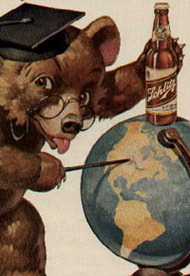The job doesn’t look exactly like blogging, and you can be pretty sure that when Beck’s owner InBev suggests its digital columnist should be offbeat that means topics only broadly related to beer may be prominent, but here’s the press release and you can decide:
Greener pastures await avid writers! Beck’s, one of InBev’s Global brands and the number one German beer in the world, present in over 100 countries, has just launched a global search to find the ultimate, offbeat columnist with an uncompromising point of view who can connect and interact with consumers in the digital world. Potential candidates can find their dream job at www.becks.com.
Fuelled by discovering and adding their personal spin on news, people, and ideas that encompass the Beck’s brand philosophy “Different by Choice,” the ideal candidate will bring their personal charisma, authenticity, and excitement to our consumers online. “Beck’s is a brand that has always refused to compromise and what we’re doing online is no different,” says Jorge Inda Meza, Global Marketing Manager for Beck’s. “Our consumers actively seek out links to new trends and genuine material from around the globe. They have a desire to learn about people who share the same values as they do. The Beck’s new columnist will help uncover and highlight relevant and exciting topics for our consumers, enabling us to better connect with them.”
The ideal candidate must be:
* A Beck’s beer lover (of course)
* Charismatic, spirited and people-loving with a great sense of humour
* Investigative with awe-inspiring writing skills
* A web-savvy individual with work published online e.g. blogs, sites, etc.
* Proficient in English (other languages are a plus)
* Quick-thinking and an independent self-starter
* Able to commit to a 6-month contract
* Authorised to work in the E.U. for any employer
* Willing to relocate to Amsterdam, Netherlands
* Above the Legal Drinking Age in their countryThe new recruit will be responsible for finding and communicating their views on examples of people and trends from around the globe that are “Different by Choice” on the Beck’s website. They will talk to and engage consumers in also sharing their point of views. As part of the Beck’s creative team, the new recruit will also help with conducting web research, performing brand-tasks, do a little bit of travelling and most importantly, maintaining an authentic and open dialogue with the Beck’s consumers.
“This is the perfect position for an adventurous writer with an open mind whose column will be seen around the world. Our new online columnist should have a knack for giving their personal flavour on authentic and exciting things that are out there,” explains Frederic Landtmeters, Global Brand Director for Beck’s. “Anyone who is web-savvy and has excellent writing skills can apply at www.becks.com. We’re really looking forward to reviewing the submissions.”
I expect this will get plenty of attention.
 No imported beers for us in the next year and change.
No imported beers for us in the next year and change.